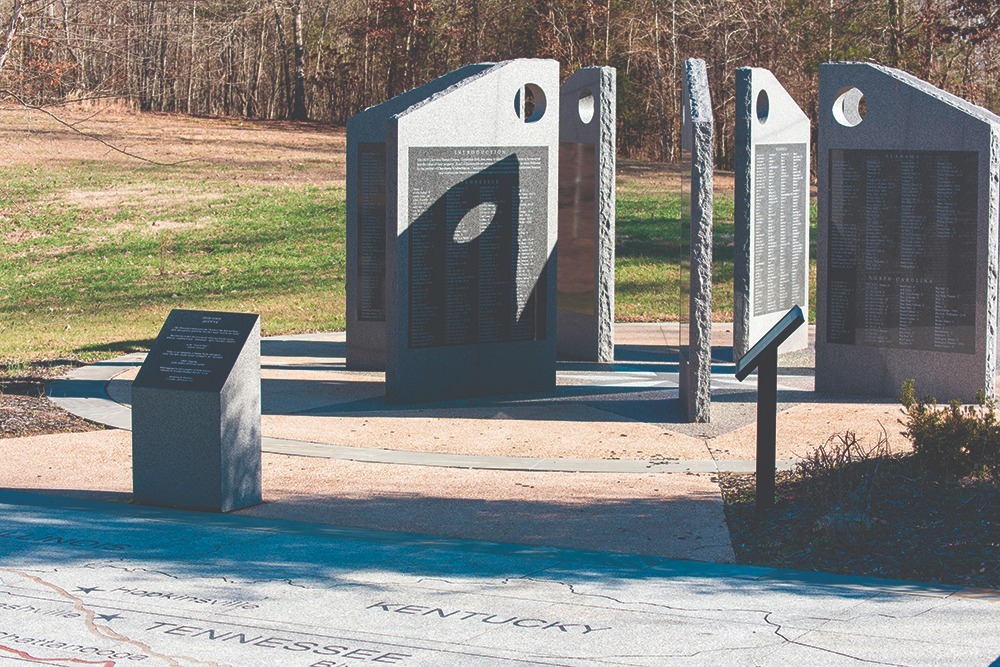
This article is a preview from the Summer 2020 edition of New Humanist
Three University of Mississippi students stand holding guns, including a semi-automatic rifle, in front of a bullet-punctured sign. The photo was posted to Instagram on 1 March 2019 and surfaced in the news the following summer. The sign marked the spot where the body of Emmett Till was found in 1955, at the confluence of the Tallahatchie River and the Black Bayou. Till was a 14-year-old black boy who was brutalised and murdered for allegedly whistling at a white woman. The sign was the third of its kind to be erected. The first was stolen in 2008. Its replacement was vandalised, accruing more than 100 rounds of bullets over several years. The third lasted a month before it was also shot at. That this plainly worded sign could draw so much ire speaks to a history of racial violence. The historical markers were born of the desire to memorialise Till and the long history of violence against African Americans. The vandalism demonstrates that some white Americans would prefer to deny it ever occurred.
Rarely are historical markers neutral. Nor are they generally effective in shedding light on histories that a majority may prefer to forget. What they choose to reveal and withhold play a role in the construction of national, racial, regional and historical identities. They are deeply implicated in the social construction of history and, consequently, in the contemporary fabric of society.
Commemorative signage, like the Emmett Till highway markers, can fail to provide meaningful context by providing one or two historical facts that together amount to incomplete or confusing statements. While major facets of Till’s story – such as the location of his murder or the acquittal of his killers – have received little attention, relatively inconsequential elements like where his body washed up have been pointed out for the public with context-free, state-sponsored commemorative signs.
How something is remembered depends on the conditions and power relations in a given place. The Mississippi Delta authorities have spent more than $5 million on roadside markers and museums since 2005. But these new attractions did not provide meaningful critical engagement with the state’s history of plantation slavery, segregation and racist violence. Professor Dave Tell, the lead researcher of the Emmett Till Memory Project, argues that the three vandalised signs should be put in museums, because “They convey the truth more completely ... by refusing us the comfort of believing that racism is a thing of the past.”
Histories that are ultimately rooted in slavery are often complex to commemorate. For Britons, the slave trade is still largely known as a story about its ending: a moment of national conscience that stopped a short-lived aberration within an otherwise benign project of global British “trade”. But the bicentenary of abolition in 2007 (which saw an explosion of public activity in the UK, including £15 million of Heritage Lottery Fund money going to Abolition-themed exhibitions) generated debate and historical engagement. Events done well, like the Docklands Museum’s exhibition “London, Sugar and Slavery” (now a permanent gallery), highlighted the inadequacies of how slavery is taught at schools. It presented that “quintessentially English” activity, tea-drinking, to tell the colonial story of Chinese tea and slave-grown Caribbean sugar. Others, like Kensington Palace’s empire-themed evenings in October 2019, at which I was a speaker, brought together artists, academics, curators and journalists for a public discussion, but the ticket price of this and similar late openings at museums limited their reach. Meanwhile, the mixed reaction to the announcement of a new London-based slavery museum last year showed that many are not even convinced of the need to remember.
* * *
Historical commemoration can provide a field for meaningful public debate, but it doesn’t always survive the weight of this task. Turkish artist Mehmet Aksoy’s Statue of Humanity was a monument to Armenian–Turkish reconciliation erected in 2009 in the Turkish city of Kars near the Armenian border. The 30-metre human figures reaching for each other were described as “freakish” by Turkey’s President Recep Tayyip Erdoğan. Ironically, the nationalistic abuse it received in Turkey’s pro-government media during its two short years of existence reflects all too well the experience of being an ethnic or religious minority in Turkey. The physical presence of statues can bring about particularly intense, but not always conciliatory, reckonings with a collective past.
Rhodes Must Fall was a movement that began on 9 March 2015 at the University of Cape Town. Originally a protest against the campus statue of the ardent imperialist Cecil Rhodes, it soon led to a wider movement addressing the persistence of systemic racism and exclusion in South African institutions. A year later, a group of students at Oxford University demanded the statue of Cecil Rhodes at Oriel College be removed. Once again, the Rhodes statue was a symbolic vehicle for a demand that the university address its colonial legacies. Drawing attention to the culture of racism, sexism and elitism that continues to lend eminence to men like Rhodes, the statue in Oriel College now stands with its meaning forever changed. Meanwhile, the University of Cape Town took theirs down in 2015, and in 2018 renamed their Jameson Memorial Hall (named after Rhodes’ political ally) as Sarah Baartman Hall, in remembrance of a Khoi woman who was sold into slavery and exhibited as a curiosity in England in the late 1700s. One outcome of both cases – whether with statues kept or removed – was the same: the politics of commemoration revealed the continuity between the historical and contemporary location of power.
* * *
Impactful public memory work creates new conditions in the present. In 2019, a series of events marked the 25th anniversary of the Rwandan genocide. Some commemorative events were symbolically powerful, like the mass candlelit night vigil at Amahoro Stadium in Kigali. Some were deeply personal, like photographs of victims displayed by their families at the Kigali Genocide Memorial. In the “reconciliation village” of Mbyo, genocide survivors and perpetrators walked together to farm fields – a collective act meaningfully charged with future benefits.
Memories of the removal era and the old Cherokee republic in the United States have similarly been crucial for tribal leaders who are imagining, debating and constructing the Cherokee Nation of Oklahoma today. In the 1980s and 90s, Cherokee Nation citizens and tribal leaders became significant participants in a commemoration of the Removal, the forced relocation between 1836 and 1839 of the Cherokee Nation and black slaves, called the Trail of Tears National Historic Trail. The process of creating the trail and associated archives provided a field for the politics of the emerging indigenous state as Cherokees considered how best to heal the open wounds left by the destruction of the old nation.
The purpose of historical commemoration is not to stage a reckoning, nor a defence. It should bring to light histories hidden by the machinations of power and point to where their contemporary legacies lie. Keeping collective amnesia at bay, public history work should centre the voices of those disadvantaged by the pasts in question. Historical honesty is hard: emotions can run high and the stakes can seem personal. Done effectively, it may cause discomfort not because it intends to, but as a result of the critical thinking it generates. The most effective modes of remembrance help us live with what has been destroyed beyond restoration and to clearly see the present we can still reshape.

